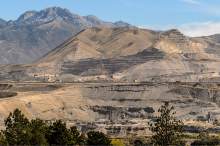This is an archived article that was published on sltrib.com in 2015, and information in the article may be outdated. It is provided only for personal research purposes and may not be reprinted.
Subterranean plumes of toxins. Waste disposal operations that may or may not be operating according to code. Meth labs in dilapidated houses. Those are all things that state and local officials responsible for enforcing environmental laws might understandably miss.
But the Geneva Rock gravel mine that straddles the border between Salt Lake and Utah counties sits right on the most heavily traveled section of highway in the state. It's not in a building, not underground, but about the most visible industrial operation that can be imagined.
They don't call the local terrain Point of the Mountain for nothing.
So it is troubling indeed to hear, as we did last week, that the state agency in charge of regulating mines failed to notice what is credibly alleged to be some unpermitted operations at the mine until a local resident, a critic of the plans to expand the operation, called them out.
It is even worse to be told, as another state agency confirmed, that nobody knows just what amounts of dust, containing which potentially harmful chemicals, are blowing out of the mine and into your lungs because there are no monitoring stations set up around the gravel mine.
The first oversight of oversight attaches to folks at the Utah Division of Oil, Gas and Mining, who had to have it pointed out to them that the mine, allegedly, is digging up gravel on the Salt Lake County side of the property, which isn't currently allowed, and not just the Utah County side, which is.
Only after one of the more studious critics of the mine's application to expand pointed that out did the division issue a cessation order to Geneva. The company has not admitted any wrongdoing, and has the right to appeal that stop-work order.
The reason some folks are understandably opposed to the mine's proposed expansion is the fear that the facility already spews large amounts of dust into the surrounding environment. And the dust may not be just dust. It could contain amounts, trace or otherwise, of such harmful substances as uranium and arsenic.
Even if that by-product of the mine isn't particularly toxic on its own, air quality concerns all along the Wasatch Front are serious enough that just adding to the amount of particulate matter in the atmosphere is, or should be, cause for regulatory concern.
Yet the Utah Division of Air Quality has no monitoring gear aimed at sampling the emissions from the gravel mine.
Before state and local officials even think of allowing Geneva to add another 189-acre area to its mining operation, as it has applied to do, the proper authorities need to demonstrate that they are ready, willing and able to police the existing operation, much less a larger one. And to have the costs of those oversight operations borne by the company that stands to profit from a larger, and more dangerous, mine.



